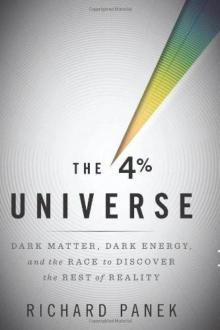The 4-Percent Universe


Author: Richard Panek
Category: Other3
Published: 2011
Series:
View: 176
Read OnlineAmazon.com ReviewA Q&A with Richard Panek, Author of The Four Percent Universe Q: What is the "four percent universe"? Panek: It’s the universe we’ve always known, the one that consists of everything we see: you, me, Earth, Sun, planets, stars, galaxies. Q: What’s the other 96 percent?Panek: The stuff we can’t see in any form whatsoever. At a loss for words, astronomers have given these missing ingredients the names "dark matter" and "dark energy."Q: What are dark matter and dark energy?Panek: If you find out, book yourself a flight to Stockholm.Q: So nobody knows? We're not talking about "dark" as in black holes?Panek: No. This is "dark" as in unknown for now and possibly forever.Q: Well, then, what do astronomers mean by "dark matter"? Panek: A mysterious substance that comprises about 23 percent of the universe.Q: And dark energy?Panek: Something even more mysterious that comprises about 73 percent of the universe.Q: Okay, 73 and 23 add up to 96 percent, which does leave a four percent universe. But if we don’t know what dark matter and dark energy are, how do we even know they’re there? Panek: In the 1970s, astronomers observed that the motions of galaxies, including our own Milky Way, seem to be violating the universal law of gravitation. They’re spinning way too fast to survive more than a single rotation, yet we know that our galaxy has gone through dozens of rotations in its billions of years of life. Galaxies are living fast but not dying young—a fact that makes sense only if we say that there’s more matter out there, gravitationally holding galaxies and even clusters of galaxies together, than we can see. Astronomers call this substance dark matter.Q: And the mysterious dark energy?Panek: In the 1990s, two independent teams of astronomers set out to discover the fate of the universe. They knew the universe was born in a big bang and has been expanding ever since. Now they wanted to know how much the mutual gravitation among all this matter—dark or otherwise—was affecting the expansion of the universe. Enough to slow it down so that the universe would eventually grind to a halt, then collapse on itself? Or just enough that the expansion would grind to a halt and stay there? In 1998 the two teams came to the same conclusion: the expansion of the universe isn’t slowing down at all. In fact, it’s speeding up. And whatever force is counteracting gravity is what they call dark energy.Q: Do astronomers have any clue as to what dark matter and dark energy might be? Panek: Yes and no. As for dark matter, they think it might be one of two subatomic particles, but physicists have been looking for these particles for thirty years and still haven’t found them. As for dark energy, they don’t even have an idea of what it might be. They’re still trying to figure out how it behaves. Does it change over space and time or not? If they can answer that question, then they can start to worry about what dark energy is.Q: If astronomers themselves don’t know what dark matter and dark energy are, why should people believe that they exist? Panek: Scientists like to quote a saying of Carl Sagan’s: "Extraordinary claims require extraordinary evidence." Many astronomers in the 1970s strongly resisted the idea of dark matter until the evidence became overwhelming. And even the two teams of astronomers that discovered the evidence for dark energy in 1998 resisted the idea until they could no longer come up with another explanation. Q: Sounds like science is a pretty straightforward process of discovery and follow-up.Panek: Straightforward, maybe. Pretty, no. As I show in The Four Percent Universe, the discoveries involved a lot of behind-the-scenes rivalries that sometimes turned ugly—rivalries that continue to this day. But in a way, these rivalries have been good for the science. When scientists who would like nothing more than to prove one another wrong wind up agreeing on a weird result, their peers can’t help but take the result seriously. Astronomers hate to say it—they’re as superstitious as anyone else, and they think they’ll jinx their chances—but there are Nobel Prizes at stake here.Q: So this is real. Astronomers actually believe that 96 percent of the universe is "missing"?Panek: Yes. They call it the ultimate Copernican revolution. Not only are we not at the center of the universe, we’re not even made of the same stuff as the vast majority of the universe.Q: What now?Panek: Nobody knows! And for astronomers, that’s the exciting part. Again and again, at conference after conference and in interview after interview, I’ve heard astronomers say that they can’t believe how fortunate they are to be scientists at this point in history. Four hundred years ago, Galileo turned a telescope to the night sky and discovered that there’s more out there than the five planets and couple of thousand stars that meet the eye. Now astronomers are saying that there’s more out there, period—whether it meets the eye or not. Lots more: the vast majority of the universe, in fact.Q: If this revolution is such a big deal, why haven’t we heard about it?Panek: Because it’s just beginning. Only in the past ten years have scientists reached a consensus that what we’ve always thought was the universe is really only four percent of it. Now they feel that figuring out the missing 96 percent is the most important problem in science.Q: Will finding answers make our lives better? What’s the payoff? Panek: On an immediate, day-to-day, price-of-milk level, nothing. But Galileo’s observations starting in 1609 completely changed the physics and philosophy of the next four hundred years in ways nobody could have anticipated. As I argue in The Four Percent Universe, this new revolution is going to have the same kind of effect on civilization. The fun is just beginning.From Bookmarks MagazineExploring “one of the most important stories in the history of science” (_Washington Post_), Panek nimbly outlines recent findings in physics, astronomy, and cosmology and evaluates rival theories in clear, comprehensible language. He also dives into the bureaucratic morass and professional enmities of contemporary research, examining how these discoveries were made as well as who made them. While some critics appreciated this behind-the-scenes human drama as a tool for understanding the full story, others believed that Panek’s alternating focus on the scientists themselves detracted from the actual science. However, even readers who prefer their science straight up will find much to admire in this accessible and fascinating survey of one of the most exciting—and maddening—fields of study.
 Earls Errand
Earls Errand God Save the Queen!
God Save the Queen! The Legend of Elora: Book 1 A Queen's Quest
The Legend of Elora: Book 1 A Queen's Quest Red on White
Red on White Bound to the Alpha: Part Two
Bound to the Alpha: Part Two To Whom it May Concern (The Hart Duet Book 1)
To Whom it May Concern (The Hart Duet Book 1) The Royal Runaway
The Royal Runaway